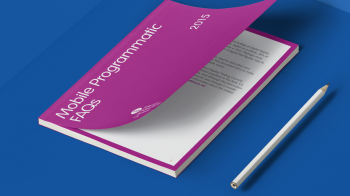To header bid or not to header bid?
Bill Swanson
Bill Swanson, VP EMEA of PubMatic, tries to answer this very common question within programmatic.
It’s the question that we’ve been most frequently asked over the last year as premium publisher’s wrestle with truly understanding the new programmatic tactic of header bidding.
Except, header bidding isn’t a new tactic, the technology behind header bidding has been around for several years. The reason it’s been a hot topic over the past year is primarily, because header bidding isn’t a straightforward technology. Debates have emerged (especially in trade media) on its efficacy, implementation complexity — and, more broadly, whether it is the natural next step in the evolution of digital advertising.
Given these debates, we decided to take a look back at the successes and challenges that we’ve seen in header bidding over the past twelve months in a white paper titled, “Lessons Learned in Header Bidding.”
The new white paper pulls together key learnings into one cohesive document in an attempt to surface the main things that publishers should take into consideration before deciding on whether header bidding is the right strategic option for them. Learnings such as, what role technology partners play in the pre- and post- implementation phases, whether header bidding will pave the way for new innovations such as wrapper tags and whether this is the beginning of the shift in control around ad decisioning back to the publisher (see more in Lesson 6).
Below are the key takeaways we uncovered in the white paper:
1. Understand if Header Bidding is Right for You: Before implementing a header bidding solution, there are a number of pre-sale and pre-implementation questions that both strategic and technical teams at a publisher should ask themselves before implementing header bidding. For example, publishers need to understand their inventory mix, take stock of resources, assess direct vs. indirect sales priorities, evaluate their current priority setup in their ad server and identify average CPMs and fill rates from demand partners.
2. Heed Expectations and Understand the Potential Pitfalls: Results from header bidding take time to develop and depend on a number of factors, including: 1) a publisher’s overall familiarity and experience in header bidding and ad decisioning, 2) whether a publisher has the operational and technical teams to implement and optimise header bidding and 3) whether a publisher attracts significant site traffic and inventory demand to necessitate header bidding.
3. Set Both Short- and Long-Term Expectations in Header Bidding: In the short-term, priorities should be around setting up a sustainable, low-touch process, where publisher-side technical staff understands how to manage their ad server line items. With regard to long-term results, header bidding should lead to higher overall CPMs, as the both buyers and sellers “learn” how to better price inventory. The end goal in all this technical setup should be to create a foundation that allows media buyers to access a publisher’s entire ad inventory and buy any inventory that meets an advertiser’s campaign objectives
4. Define Who is in Charge and of What: When implementing a header bidding solution, publishers and technology partners need to define the roles and responsibilities of team members on both sides. Once roles are defined, specific responsibilities must be assigned to all stakeholders throughout the phases of implementation: pre-sale, pre-implementation preparation, header tag implementation, post-implementation testing and measurement.
5. Test, Test… and Then Test Again. Successful optimisation requires post-integration testing on a daily basis, combined with weekly check-ins with a tech partner’s strategic and technical team members. Publishers should follow these three key steps: 1) Ensure there is open communication and agreement data sharing between publisher and technology partner, 2) Reset success metrics to include price, fill rate, bid rate (i.e. the number of bids coming in from the buyers) and win rate and analyse the performance of each and 3) Measure the bid response latency and creative latency separately.
6. Prepare for Wrapper Solutions in 2016: Publishers need to understand if they should be integrating a wrapper solution, when they should implement and what they can expect from a fully integrated wrapper solution. Enterprise-level wrapper solutions provide publishers with control panels so that ad ops teams can manage multiple header tags (i.e. add or remove tags easily), demand levers that allow publishers to automate decisioning from both direct and indirect demand sources and integrated analytics and real-time reporting capabilities.
To download the white paper, click here.
Related content
Cross-industry Programmatic Taskforce announces mission & objectives
Learn moreAdform: RTB Trend Report Europe Q4 2014
Learn moreTubeMogul: A UK advertisers guide to programmatic TV
Learn moreMobile Programmatic FAQs
Learn more
Rediscover the joy of digital advertising
Champion connections instead of clicks. Capture audiences' imaginations, not just their attention. Boldly find your own beat instead of letting tech set the pace. It’s time to rediscover the joy of digital.



